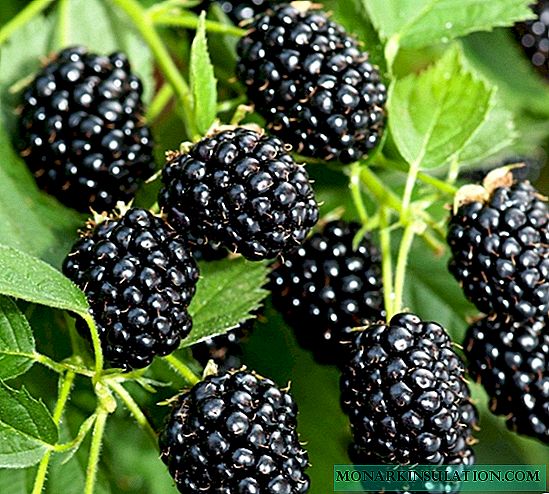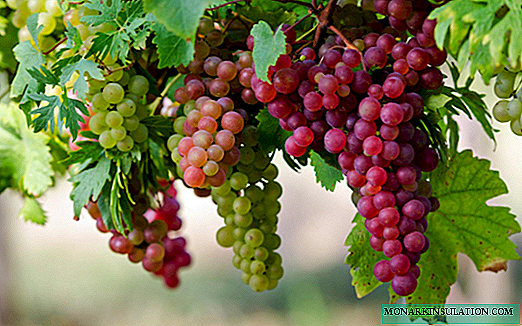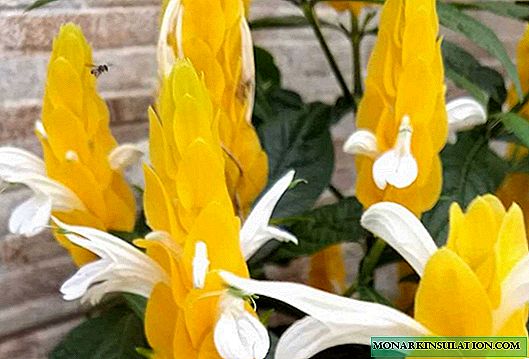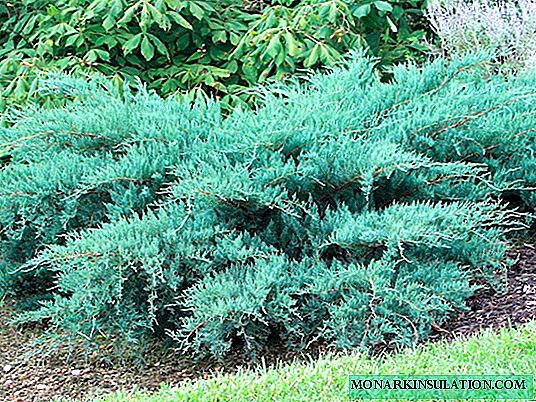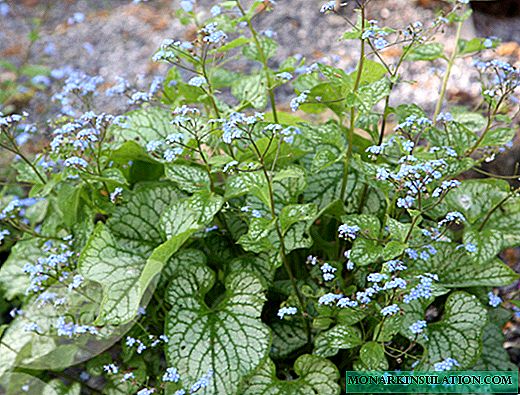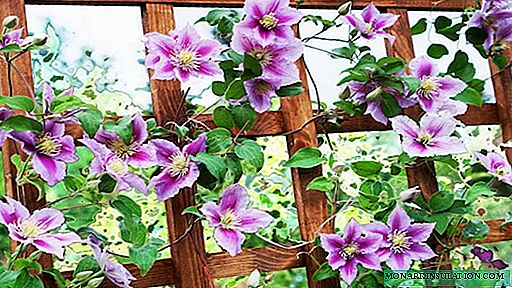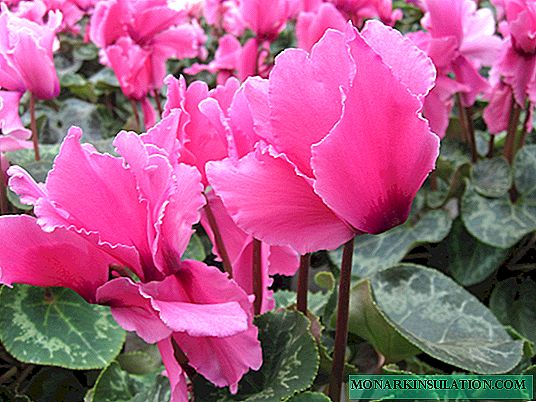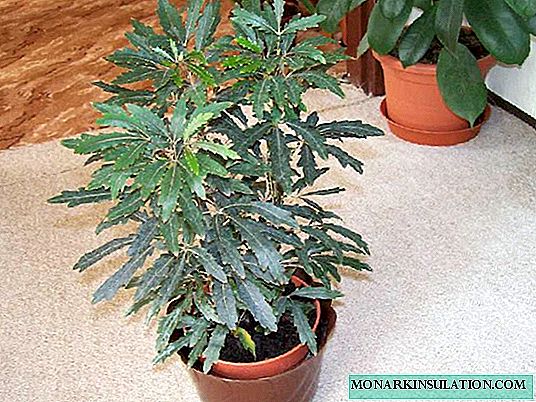Salpiglossis (Salpiglossis) is a genus of plants in the nightshade family. Another name for the pipe language comes from the shape of a floral corolla, which looks like a folded tongue. Homeland is South America: Peru, Argentina, a large number grows in Chile.
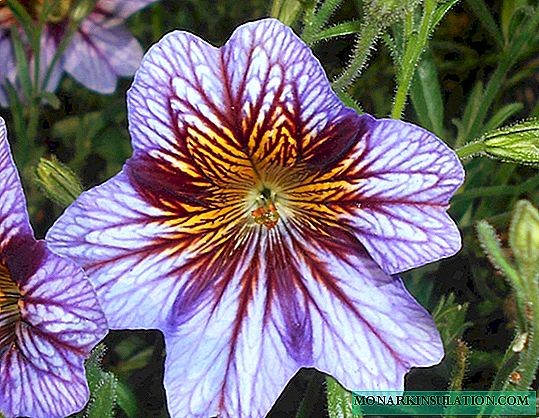
Salpiglossis flower description
This is an annual plant with an upright thin stalk. Height varies from 50 to 100 cm, branching is insignificant. The shoots are evenly covered with short bristly hairs, seem sticky to the touch.
Root system of the mixed type: with the main stem and developed lateral roots.
The leaves are dark green, at the base of the shoots grow on petioles, the shape is oblong. On the middle tiers are short-leaved, on the upper sessile, narrow, notched-lobed. It occurs as a flat edge of the sheet plate, and with the teeth.
The flower is large, 4-6 cm in diameter, grows on a stem alone. It looks like a funnel of the correct form. Has 5 petals - blades. The color is varied, saturated: purple, yellow, shades of red, blue. A distinctive feature is the expressive lines on the petals: gold, burgundy or scarlet shades. Each marble strip pattern is unique and non-repeatable. The shape of the flower is like a bell, and the color is like an orchid. Flowering continues from mid-summer to September, in a warm climate until November.
The seeds are light, formed in oval boxes. They have a long germination period of 4-5 years.
Types and varieties of salpiglossis
The genus has 20 species, but only one is used for cultivation in the garden - salpiglossis is notched. Several forms were deduced from it by selection:
- Large flowered. The highest - 90 cm, densely branching with large buds.
- Superbissima. A distinctive feature is the surface of the petals, corrugated with pronounced veins. The bush is medium-sized up to 60 cm.
- Low. Dwarf: up to 40 cm, lush and plentifully flowering. Suitable for growing in containers.

Popular varieties:
| Grade | Features | Flowers | Height (cm) |
| Kew Blue | Grown in greenhouses or used for distillation in spring. | Bright pink and purple shades with golden streaks. | Up to 30 |
| Casino Mix | It must be tied to the supports. | Multi-colored. Red with yellow pharynx. | 40-50 |
| Festival and Flamenco | The most undersized. | The color is varied. | Around 30 |
| Bolero | Abundant flowering, stems strong. It tolerates direct sunlight and a small partial shade. | Pink with raspberry stripes. | Up to 60 |
| Ali Baba | Fragile tall stems need support. Flowers fit the cut. | Cream, violet, yellow. The colors are saturated. | 70-80 |
| Velvet Dolly | Compact, the color of the buds is saturated. | The surface of the flower is velvety. | 40 |
| Fireworks | Good for bouquets or landscape design. | Bright lilac. | 50-65 |
| Magic | Large flowers up to 6 cm. | Many shades of red, white with yellow streaks. | 40-60 |
Growing Salpiglossis
Planting and caring for salpiglossis is quite simple, it is necessary to comply with the proposed recommendations. Thanks to this, exotic flowers will please the gardener for a long time with their brightness and unusual beauty on the flower bed, and some varieties on the windowsill.

Reproduction of salpiglossis
Propagation occurs with the help of seeds, which are sown for seedlings in containers in March, laying on the surface of the soil and not sprinkling with earth. The pot should be no more than 5 pieces. For germination, cover with a bag and put in a warm shaded place. Optimum temperature +20 ° C.
To speed up the emergence of seedlings and prevent subsequent sunburn, put white paper on top.
Seedlings should be dived carefully so as not to damage the root system. The best time for this procedure is the appearance of one or two leaves. When transplanting to a flower bed, it is necessary to preserve a part of an earthen coma on the roots, this will help rooting in a permanent place.
You can also use the reckless way of growing. At a distance of 25 cm from each other, holes 2.5 cm deep are made, the seeds are lightly sprinkled with earth and moisturized.
Sown in open ground in April - early May, then the plant will bloom in July. In areas with a warm climate, you can sow in late autumn, then the buds will appear earlier.

Soil selection and preparation
Before sowing or planting on a flower bed, you must prepare the soil. For 7-10 days, dig a selected area, add ash and sand. Good is the presence of humus in the ground. The plant prefers a neutral or slightly acidic environment: pH 5.4-7.0. Therefore, peat is added in small quantities.
Soil is needed loose and easily passing water. Stagnant fluid is contraindicated, the ground should be slightly moistened.
If the soil is lean, just before planting, another piece of ash is introduced and the flower bed is again dug up. The plant reacts strongly to lack of nutrients: flowering and bud formation cease.
Location
The best place for landing is a light and protected from strong draft site. In the shade, growth is possible, but flowering will be weak.
Dangerous Diseases and Pests
The plant is affected by diseases such as:
- Root or stem rot, due to an excess of water or frequent watering.
- Fungal diseases: powdery mildew and late blight.

Most infected flowers die. To prevent this, you need to regularly inspect the bushes and treat with fungicidal preparations.
Salpiglossis is resistant to many pests, the main enemies are:
| Pest | Signs | Elimination |
| Aphid | The plant has a painful appearance. Foliage turns black and withers. The buds change shape and fall off. | Peels of lemon or orange: 0.5 cups of water 100 gr to insist 3 days. Soda-soap solution: per 1 liter of hot water, 1 tbsp. l soda and ¼ bar of soap. |
| Thrips | Yellow or colorless spots and stripes on leaf blades and petals. Withering and falling of greenery, dying off shoots. | Humidification of air. Regular inspection of plants. Treatment with drugs: Intavir, Karate, Actelik and others. Sprinkle tincture of garlic, in a glass of boiling water 2-3 cloves. |
| Spider mite | Treatment with soapy water: 300 g per 10 l infusion of onion husks 100 g per 5 l. The use of acaricides: Neoron, Skelt, Fitoverm. |
Caring for Salpiglossis in the Garden
Salpiglossis is an unpretentious plant. However, care should be based on the following recommendations:
- Tall varieties are attached to supports, this prevents breakage of thin stems and maintains a neat appearance.
- The plant likes regular watering. Lack of fluid negatively affects flowering and growth. To avoid an overabundance, it is necessary to wait until the soil dries. In hot weather, moisten the flower bed every day. In autumn, the frequency is reduced to 2-3 per week.
- For the formation of lush compact bushes, the tops need pinching. In the period of seedling growth, this is done 3-4 times.
- The number of buds will increase if wilted flowers are removed.
- Salpiglossis loves hydration, always spraying in the evening hours.
- Frequent top dressing with mineral fertilizers is needed. It is suitable for blooming complex, you need to make it every 2 weeks. You can also use ash.
- Weeding and loosening the soil.
Salpiglossis wintering
In regions with a cold climate, the plant grows for one year in open ground. Perennial only suitable for the southern regions. You can try to transplant salpiglossis in the fall into a pot, however, not all varieties take root. For this, high containers with a layer of drainage at the bottom are suitable. To further lighten the soil add pieces of charcoal.
The plant needs diffused light, direct sunlight is possible, but for a short time. In the room, the western and southwestern window sills are optimal. With a lack of light, it does not bloom and stretches in height.
The southern flower does not like cold, the temperature should not be lower than + 16 ... +18 ° C. If the room is warmer than +25 ° C, ventilation is required.
Mr. Dachnik recommends: salpiglossis in landscape design
Salpiglossis, due to its decorative effect, is widely used in landscape design. In group plantings on flower beds or discounts, and also adjacent to:
- petunias, especially white ones, as a bright accent;
- salvia;
- cineraria;
- marigolds (you can effectively arrange a gazebo or flower bed);
- decorative cabbage;
- matricaria;
- Chrysanthemum
- coniferous plants.
Flowers will look original in bouquets. After cutting, they retain an attractive appearance for a long time. The best option is to plant a plant along the paths or to the fore flower beds. Strong remoteness makes it impossible to admire the colors.
Salpiglossis is an exotic southern representative who will decorate flower beds in the garden. Due to the variety of colors, each grower will choose the appropriate option.


